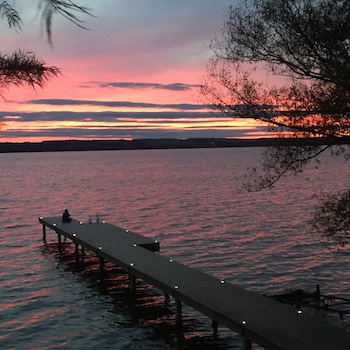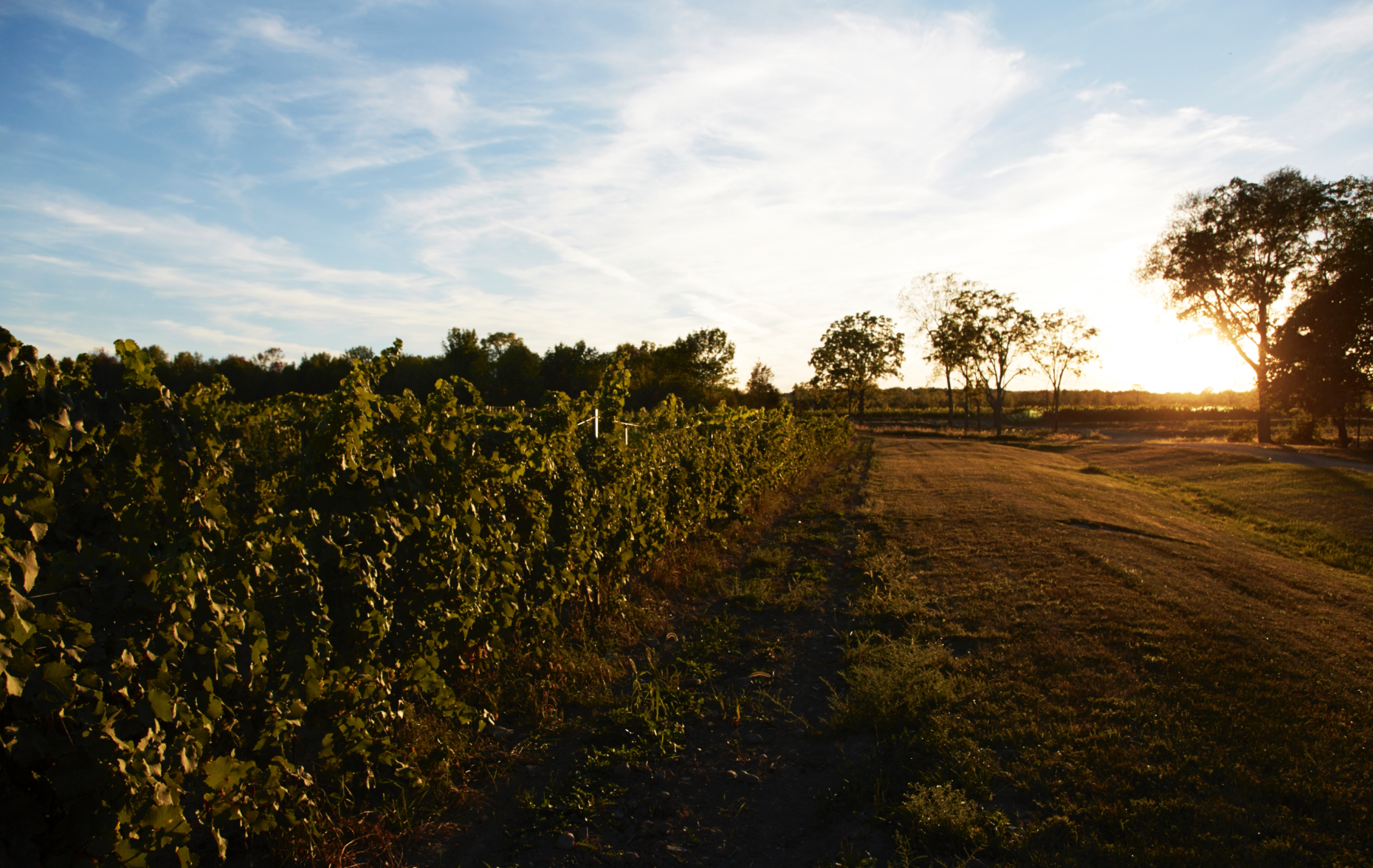
(Photo, above: Hermann J. Wiemer Vineyard, courtesy of fingerlakeswinecountry.com)
More than a century before the Judgement of Paris, an American wine shocked European palates by beating the Old World at its own game. In 1873, the Finger Lakes’ Pleasant Valley Wine Company entered its “champagne,” made from native Catawba grapes, into the wine competition at the World Exposition in Vienna — and took first prize. New York wines were thrust into the global spotlight, ushering in a period of unprecedented prestige for a region that had been better known as the humbler domain of grapes for juices and jams.
But then, starting with Prohibition, came decades of setbacks. After repeal, there was a hard liquor backlash, followed by a very gradual revival of local wine culture that focussed on native and hybrid grapes (then largely dismissed by the fine wine world as infra dig). It took the courage and commitment of two European harbingers, Dr. Konstantin Frank and Hermann Wiemer, to raise Finger Lakes wines to Old World standards, on the strength of their pioneering successes in cultivating vinifera varieties.
Another few decades of experimentation, significant state winery law changes, evolving consumer tastes, and nothing less than a sweeping generational shift were prerequisites for the impressive renaissance in Finger Lakes wine we’re witnessing now.
Last fall I got to take a closer look at who and what are behind this remarkable rise. As part of Harvest House — sleepaway camp of sorts for urban wine professionals — I joined a clutch of New York City-based retail buyers (and a somm) for hands-on harvest work in the some of the most influential vineyards and cellars in the region, including Boundary Breaks, Hermann J. Wiemer, Dr. Konstantin Frank, Anthony Road, Damiani, and Red Newt Cellars.
Each morning, after fueling up on coffee and peerless views of Seneca Lake (we were comfortably bunked in houses on its shores), we set off for day-long stages at various wineries, sampling and sorting grapes, tracking fermentations, hosing off equipment, rigging pumps, punching down caps, wiping out tanks — and of course tasting the wines.
(Photo, left: In the Finger Lakes, it's not just the wines that are lit.)
In the evenings, we returned to our shared digs just in time to catch the reflection of iridescent sunsets in our glasses. We talked with and learned from prodigies like Kelby Russell of Red Newt and OGs like Phil Davis of Damiani Cellars, Dave Breedan of Sheldrake Point, and Josh Wig of Lamoreaux Landing. Dinners were impressive showcases of local produce, an outgrowth of the broader agricultural revival underway here, which extends to whole-animal butchery, artisan dairy products and preserves, and (dare I add?) excellent ciders and beer.
As a wine region, the Finger Lakes is distinguished by a cool continental climate, tempered by the protective influences of several narrow, vastly deep lakes. Winemakers must maintain a taut balance here, farming near the limit of where vinifera grapes can grow. It’s not that the latitude is so high (compare the Finger Lakes’ 42.5°N with the Mosel’s 50°N), it’s that the winters are so harsh. Without any significant geological features to block blasts of cold air sweeping down from the Arctic, winter temperatures routinely plunge low enough to threaten vine kill. Summers can be sear, as in the 2016 vintage, or extremely wet, as in 2017, requiring nimble, attentive farming, diverse varieties and sites, and a certain appetite for the unpredictable.
A growing appreciation for this singular climate (particularly in an era of global warming, when most bets are, logically, on the future of cooler sites), as well as the impressive array of glacially distributed soil types and lake-influenced microclimates, are what have attracted winemakers. The region offers ideal conditions for focussing on what Jancis Robinson recently called "twenty-first century wine... less obviously ripe, higher in acidity, lower in alcohol, lighter in colour and weight, made from grapes probably picked earlier" — serendipitously, at a time when the thirst for such wines in sophisticated markets seems unslakable.
But what I found in talking with growers and makers here is that what truly sets the Finger Lakes apart is the human factor. This is a tightly interconnected community of small, independent producers, devoted to developing their talents and terroir in tandem. In the fluid world of wine work today, most could be making wine anywhere on the planet. Many have. But they’ve chosen to put down roots here. Collectively, they’ve raised the level of viticulture, brought fresh scrutiny to cellar practices, embraced the new idiom in which wine is expressed, and above all, charged the region with thrilling energy.
All the winemakers I met seemed drawn by the force of a place with both an important winemaking backstory and an unfolding narrative into which they could write themselves. Paradoxically, it seems to be the collaborative environment that allows them to express their individuality best, especially when new investment in top-quality vineyards meets world-class talent.
(Photo, right: Morning fog lifts over Seneca Lake, just beyond the home vineyard at Boundary Breaks.)
Case in point are collaborations like those between Red Newt’s gifted young winemaker, Kelby Russell, and Boundary Breaks. Officially, Russell holds the title of winemaker at both cellars. Boundary Breaks, founded in 2008, concentrates on vineyard holdings in the milder "banana belt" on the eastern shores of Seneca Lake. Co-owner Bruce Murray says, "We wanted to create a family of Riesling wines that showcase winemaking skills from across the region, using the fruit that we have carefully managed in our vineyard." You can taste what the crossflow of expertise, perspective, and thoughtful selection of vineyard and clonal material can yield in spotlight projects such as Boundary Breaks’ Reserve 198 Riesling.
Then there is the freedom that comes with comparatively low land and grape prices. Chances can be taken. Consumers can take some risks, too. Finger Lakes wines are some of the most reasonably priced high-quality U.S. wines on the market today. Moreover, the incubator effect afforded by having been able to work below the critical radar until quite recently, with scant national or international attention or distribution, allowed winemakers to hone their identities without pressure to conform to market expectations of a particular grape or style.
It’s crucial that even the big players here are small. Family ownership is woven into the stories of wineries like Dr. Konstantin Frank, Wagner Vineyards, Lamoreaux Landing, Hermann J. Wiemer, Boundary Breaks — and many others. Five generations of the Wagner family have grown grapes on the eastern slope of Seneca Lake; Dr Konstantin Frank is now run by the fourth generation of descendants of the region’s vinifera pioneer. For the significant number of up-and-coming winemakers not yet able to own their own vines, one priority is to build relationships with the established players, and to tap into their wisdom and generosity as demand for shared resources tightens.
Among newcomers, the most successful have taken pains to study the landscape before entering it with deliberate intentions about what they want their wines to say about the Finger Lakes. Do they tell a novelistic story of the whole region? Or winnow the narrative to a grape, a lake, a vineyard, a block? Either way, the tales are captivating — and unified by a sole aim: making wines the terroir wants to give. As wine writer Eric Asimov recently noted: “It is not often in the United States that decisions about which grapes to plant are motivated more by sound viticultural reasons than by commercial concerns.” But that’s precisely what’s happening here.
Riesling and Cab Franc, for all their merited fetishizing among somms and critics, are still not go-to American wines. No one would have hazarded much on the future of Loire red varietal wines from upstate New York even ten years ago. But the dedication to finding true vins de terroir has proven itself a brilliant, long-odds bet that is now paying off in excellent wines and critical acclaim.
Nowhere is this better illustrated than at Hermann J. Wiemer, an iconic winery of the region, located in Dundee, on the western shores of Seneca Lake. Thanks to some wet weather, my mini-stage there centered on the crush pad and cellar.  As a cool, light rain fell on the vineyards just beyond us, my fellow Harvest Houser, Aurore (the somm), and I were welcomed with an engaging orientation from Wiemer co-owner Oskar Bynke. As he talked, I noticed the cellar crew working behind him, carefully filtering the water used to wash the winemaking equipment, an act that, for me, epitomized the meticulous standards to which Bynke and winemaker Fred Merwarth hold everything they and their team do.
As a cool, light rain fell on the vineyards just beyond us, my fellow Harvest Houser, Aurore (the somm), and I were welcomed with an engaging orientation from Wiemer co-owner Oskar Bynke. As he talked, I noticed the cellar crew working behind him, carefully filtering the water used to wash the winemaking equipment, an act that, for me, epitomized the meticulous standards to which Bynke and winemaker Fred Merwarth hold everything they and their team do.
(Photo, left: Oskar Bynke scrutinizes the Gewürztraminer harvest.)
With satirical German pop songs providing the soundtrack, we took up posts around a long, vigorously vibrating conveyor belt — the sorting table — and spent the morning sniffing and snipping two tons of gorgeous, deep pink Gewürztraminer grapes that had been harvested the day before. Gewürz is notorious for its powerful perfume and for being something of a sugar pump on the vine, its acid levels imperiled if not harvested at precisely the right moment: we’d been entrusted with delicate goods.
As we routed sour rot, late-season ladybugs, and the odd miniature vine snail, Merwarth’s young, articulate assistant winemaker, Dillon Buckley, and his sorting table crew offered Aurore and me a collective masterclass in all things Finger Lakes wine.
Wiemer’s European orientation is clear, with a vineyard manager from France, an intern from Geisenheim, Germany, Bynke hailing from Sweden, and Merwarth having studied in Germany as well. Their perspectives were correspondingly wide ranging, from the viability of biodynamics in the region (“It can be done.” “We’re doing it.” “The hard part is finding a vineyard that isn’t surrounded by conventional farming.” “You know, spray drift. The home vineyard is the only place that’s isolated enough,” various voices chimed in) to the influence of the Wiemer vine nursery on Wiemer's thorough understanding of varieties and sites in the Finger Lakes.
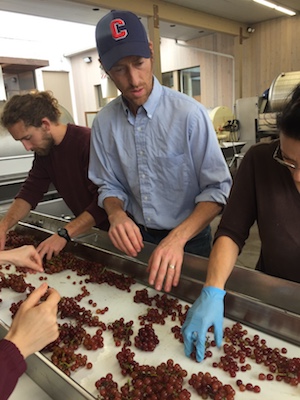
(Photo, right: Buckley and Merwarth at the sorting table.)
Bynke and Merwarth are pursuing nothing less than what they refer to as an “agrinomic art form,” pulling together the elements of low-intervention viticulture, soil type, variety, and mesoclimate. Scrupulous viticulture is essential to the mission. Wiemer uses no chemical fertilizers, relying instead on cover crops and composted manure to build healthy soils, and careful canopy management to minimize the significant disease pressures that have long driven Finger Lakes growers to favor resistant natives and hybrids.
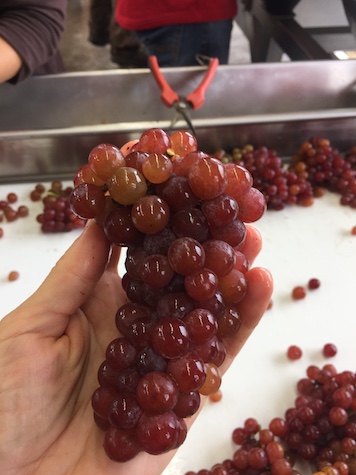
(Photo, left: Gewürz in all its glory.)
Wiemer holds an edge over everyone else in the Finger Lakes — and in the U.S., for that matter — in having a full-fledged commercial vine nursery as part of its operations. Hermann Wiemer’s father led the agricultural experiment station in Bernkastel, Germany when Wiemer was young. Wiemer assisted his father with the massive effort of replanting Mosel vineyards destroyed in World War II, painstakingly bench grafting vines by hand and learning invaluable lessons from the process. When Wiemer came to New York, severe cold-tested vinifera plant material was not commercially available. He left nothing to chance. In 1979, he opened his own nursery, using budstock from Cornell University’s experiment station in nearby Geneva.
This gives Merwarth, who also heads the nursery, a built-in laboratory for the selection of optimal, tested, clean plant material and the very specific benefit of harboring varieties in the cold climate for which they are destined, the ability to survive winter kill being chief among them. Currently, the nursery can grow up to 500,000 vines, with 17 vinifera varieties on offer, among them Gamay, Nebbiolo, Petit Verdot, and Viognier. Instructively, the grapes Wiemer focuses on in its own vineyards fall in a narrower band: Riesling, Gewürztraminer, Chardonnay, Pinot Noir, Cab Franc, and Lemberger.
Wiemer wines are critics’ darlings. No less a Riesling aficionado and authority than Hugh Johnson has declared Wiemer’s “outstanding.” Eric Asimov has praised Wiemer’s Rieslings for their floral and mineral characters. In 2017, Wiemer’s Dry Riesling made Wine Enthusiast’s Top 100, on the strength of the wine’s “impeccable value” and “cool, steel-edge persistence.”
But Bynke and Merwarth wouldn’t know what it means to rest on their laurels. This past summer, Wiemer expanded its library of exceptional vineyard sites by acquiring Standing Stone, a winery on the eastern side of Seneca Lake, notable for its significant sites of Riesling, Gewürz, and the Georgian red variety Saperavi (an improbable star of Finger Lakes viticulture). Bynke and Merwarth also have their eyes fixed on the export horizon. Wiemer leads the way in Finger Lakes exports to the Riesling-thirsty markets of Japan, Hong Kong, Singapore, New Zealand, Australia, Belgium, Denmark, and Sweden. They ship 500 to 600 cases abroad each year, with the majority going to Sweden. As Bynke explains, “They don't have their [own] domestic production, which makes them a little more open minded and exploratory. Scandinavian countries are also Riesling drinkers! Oregon and California has become rather trendy in Scandinavia so U.S. wines are doing well there. We might be riding on that wave as well.”
Our fingers stiff from so much sorting, we break for a quick lunch under a picnic shelter. Twenty minutes later, Merwarth invites me to shadow him for the afternoon, an almost comical catch-me-if-you-can situation. 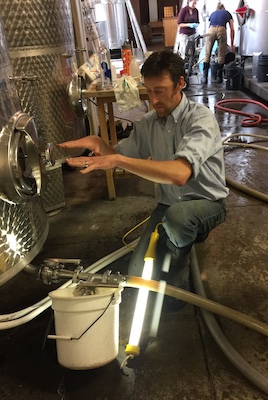
(Photo, right: Merwarth illuminates the art of racking.)
We set to racking a tank of Riesling off its gross lees. I study Merwarth’s practiced, fluid motions as he choreographs an intricate dance of hoses, buckets, valves, and electric pumps (I also pause to consider what winemaking was before the advent of these most basic modern tools.) Merwarth hands me a valve for attaching a tank to a hose. Even this simple a task takes me three tries. He gently sets me straight, a kind and patient master even as I risk the loss of hundreds of gallons of hardwon juice. Then he lopes off to the next job: wiping down tanks. He hands me a small square of cloth and a squeegee. “We work so hard to get the purest expression of the fruit, I hate to think of it being diluted even by as much as a half gallon of water that could accumulate if we didn’t get these tanks this dry,” Merwarth explains. I insert myself waist high into a towering stainless steel tank to remove what, to me, seem negligible drops of moisture, and after a few minutes, report back to Merwarth: job done.  Later I see him, back at the tank, squeegee in hand, his lanky frame swallowed up to the hips, making another pass.
Later I see him, back at the tank, squeegee in hand, his lanky frame swallowed up to the hips, making another pass.
(Photo, left: Merwarth, all in.)
We’re due back at Harvest House by five, and the time’s drawing near. But Aurore and I don’t want to leave without tasting through the Wiemer offerings. We persuade Bynke to step away from the winery’s small, tasteful retail shop, which is doing a brisk business even on this soggy weekday, to lead us. A 2016 Riesling Dry Reserve is Wiemer’s “GG,” built for 10-15 years of aging, already broad and powerful, with a beautiful density of both fruit and dry extract, blended from specific lots from all three of Wiemer’s Riesling vineyards, cold fermented for seven-plus months. Stunning methode champenoise sparkling wines, particularly the 2013 Blanc de Blanc, with 70 months lees aging prior to disgorgement, rightfully take their place alongside some of the most elegant grower bottlings coming out of Champagne right now. A gorgeous 2015 Riesling “Noble Select” from the Magdalena Vineyard, selected for botrytis, with just 20-30 cases produced, is a prime example of what Wiemer’s hyper-selective, single-vineyard-focused approach can achieve. Reluctantly, we stop there. Bynke and Merwarth send us off with a 2012 Blanc de Noir tucked under our arms to carry back to our group.
Back at Harvest House, we gather to share bottles, experiences, and lessons culled from the day. The array of wines pooled even by our small group tell the broader story of Finger Lakes wines now: Profound and joyful Rieslings that span the range from nervy and etched to rounded and deeply textural. The Cab Francs are earthy, mineral, and clarion. All manner of sparklers illuminate an array of styles depending on producer, grape, and method. Wiemer’s Blanc de Noir is clearly sui generis for the Finger Lakes, as, in a different way, is Lakewood Vineyard’s force-carbonated rosé of native Catawba grapes.
And just like that, there we are. Back at sparkling Catawba, where it all began.
Special thanks to the New York Wine & Grape Foundation for providing the opportunity to learn first-hand from the producers mentioned in this article.
---
For more on wine from the Finger Lakes, check out:
Valerie Kathawala's article on Nathan Kendall
Our interview with Christopher Bates of Element Winery
Our interview with Fred Frank and Meaghan Frank of Dr. Konstantin Frank Wine Cellars
Our interview with Kelby James Russell of Red Newt Cellars
Our interview with Fred Merwarth of Hermann J. Wiemer Vineyard
Our interview with Tom Higgins of Heart & Hands Wine Company
Our interview with Morten and Lisa Hallgren of Ravines Wine Cellars
Our interview with Shannon Brock of Silver Thread Vineyards
Our interview with John Martini of Anthony Road Winery
